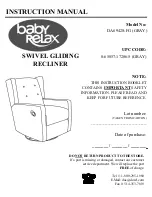
13
7. STANDING GUIDE
It is important that carers are familiar with manual handling techniques along with
any sling instructions prior to completing any patient lifts. All patient’s should have
the correct sling and transfer techniques assessed by a qualified health professional.
Explaining the lift process to the patient is important to ensure patient comfort
and confidence and whenever possible two carers should conduct patient lifts for
additional safety.
1. Patient sling positioning
Ensure that the patient is ready and lean
them forward. Slide the sling down behind
the patient until the underarm pads are just
below the axilla (arm pit). Pull the straps and
loops through under the patient’s arms and
fasten the chest strap in place.
2. Attaching the sling to the yoke
Ensure that the stander legs are open to the
maximum width and slowly position it as
close to the front of the chair as possible –
be careful to keep the boom and yoke clear
of the patient during this process.
The patient’s feet should be positioned on
the foot platform shoulder width apart. The
patient should grip the yoke for stability.
Once the yoke is at chest height on the
patient the sling loops can be attached. For
chair lifts the rear brake castors should not
be used to ensure the stander can locate its
centre of gravity easily.
3. Lifting the patient
Raise the yoke until the loops of the sling
pull tight. Check that the patient is still
comfortable and that the sling is correctly
positioned. Raise the patient slowly until the
patient is in a standing position.
1
2
3










































